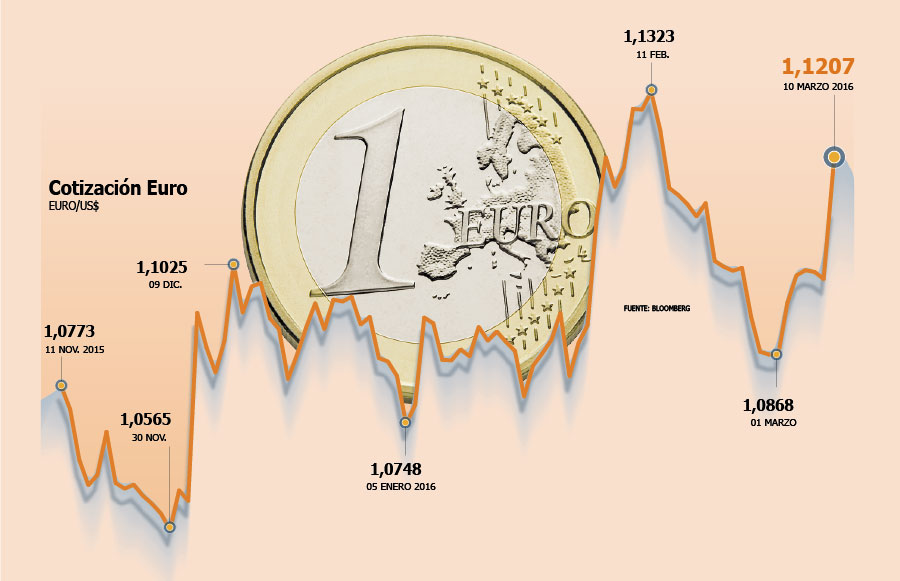Ainhoa Murga
The fragile economic recovery in the eurozone and weak prices led the European Central Bank to present yesterday a new set of stimulus measures, the most ambitious to date, which includes the greater reductions in interest rates as an extension of the QE program of buying government debt (QE, its acronym in English) that is one year old now.
After disappointment of the December meeting, ECB President Mario Draghi shot yesterday a new ‘bazooka’ market measures, saying they are necessary to prevent the slowdown in emerging economies slow down the recovery of the euro zone. After an initial burst of enthusiasm that drove global stock markets, the trend, however, was quickly reversed when interpreting the authority would be running out of wiggle room.
measures on three fronts
the European issuer lowered the benchmark interest rate from 0.05% to 0%; he cut in ten basis points the interest rate applied to the deposit facility (which charges commercial banks for leaving money in their vaults), to -0.30%; and reduced its -the marginal rate charged for loans to a day- to 0.25% from 0.30%.
In addition, from April will expand the amount of monthly debt purchases 20,000 million, the maximum range up to 80,000 million, exceeding the 70.000 billion expected by the market. As added, the ECB extended the range of QE corporate high quality bonds denominated in euros, in order to boost lending, consumption and prices.
Moreover, since June, will implement new LTRO (liquidity loans to banks long term) with a duration of four years each. The interest of these loans may be reduced to -0.4% (the type of facility marked deposit) and the last will take place in March 2017.
A year without success QE
After a year of QE and 700 billion euros spent, the ECB program has achieved few results to show, with inflation back in negative territory in February (-0.2% annually) ., due partly to the collapse in the price of raw materials
the new stimulus has two distinct lines of action: on the one hand, the general easing of monetary policy to increase the amount of purchase program active and with lower interest rates; on the other, an effort to provide banks cheaper to facilitate credit to their customers funds, which, combined with the purchase of corporate bonds, should “create conditions substantially easier financing for businesses”.
“with this comprehensive package we are providing substantial monetary stimulus to counter the increased risks to the objective of price stability the ECB,” Draghi said. “If we knew by beat, we would have deflation would increase the real value of the debt.”
Mixed Signals
The reaction to the new movement ECB it was mixed, with some analysts ensuring that this is good news in the short term, although wrong course. Others warn that strong measures will leave the issuer with less leeway if the situation worsens.
“It is far from certain that the last ‘bazooka’ the ECB will be more effective than previous ones in ensuring sustained and eliminate the threat of deflation growth, “said Capital Economics.
the market welcomed the announcement with strong initial gains later reversed, with falls of more than 4% from the highs the session, after Draghi gave signals that there will be more rate cuts and that the Council had ruled out a stepped structure of deposit rates, a system that is already used in Japan or Switzerland to stimulate lending. Similarly, the euro received the news with a fall of 1.6%, but after Draghi’s comments erased the loss and rose 1.7% to 1.1207 per dollar.
“The rates remain low, very low for an extended period and well beyond the horizon of our purchases, “said Draghi. But in view of the current conditions, “we do not anticipate it being necessary to reduce them further,” he said, reiterating that they retain tools to act if circumstances change.
Cutting out projections
the battery of measures was accompanied by a more pessimistic outlook for the economy of the region and inflation scenario. The ECB cut its growth forecast for this year from 1.7% to 1.4% and two-tenths to 2017, to 1.7%. As for prices, expected to increase 0.1% this year, from 1% previously and well below the target of 2% per year, to rebound to 1.3% next year.
stimulus package ecb
rate cut refinancing 0% rate on the main refinancing operations is reduced by five basis points, to 0%, from 16 March.
Lower lending facility rate at 0.25% the rate at which lends money to one day reduced by five points, from 16 March.
Cut the deposit facility to 0.40% Discount rate ten points this from -0.30% from March 16. Wide
debt buying up 80 billion a month Expands under the QE program 20 billion a month.
be buying corporate bonds in the bond program includes euro-denominated investment grade issued by non-banking companies of the euro zone.
new LTRO since June
The issuer will launch a new series of operations long-term refinancing, each lasting four years, since June.

No comments:
Post a Comment